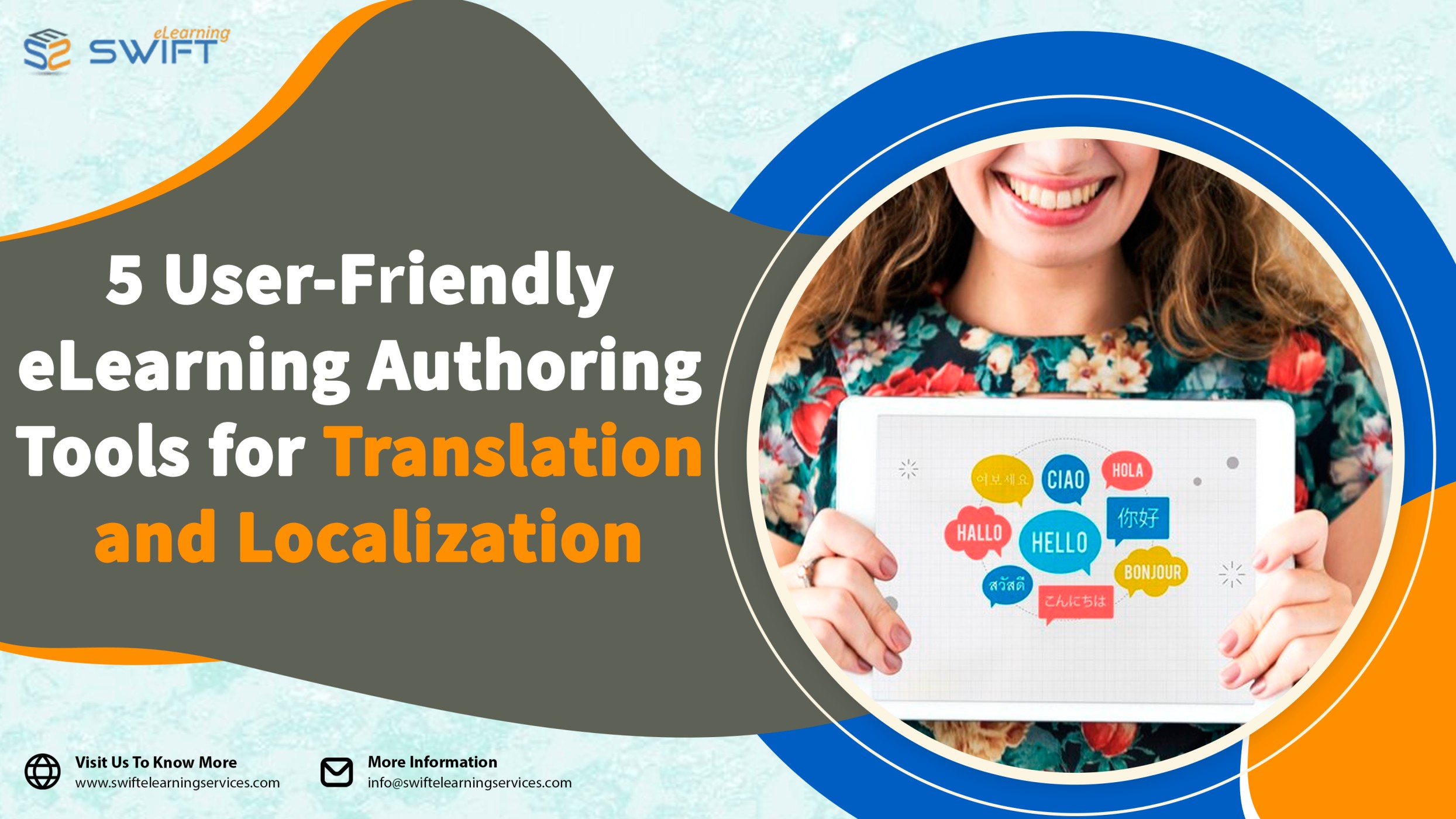5 User-Friendly eLearning Authoring Tools for Translation and Localization
In a rapidly evolving educational landscape, the need for effective eLearning tools has never been more crucial. As educators strive to reach a global audience, the challenge lies in breaking through language barriers.
This blog delves into the realm of user-friendly eLearning authoring tools, exploring their role in facilitating seamless translation and localization.
1. Understanding Translation and Localization
Before we embark on our exploration of eLearning authoring tools, let’s establish a common ground on what translation and localization entail. Translation involves converting content from one language to another, while localization goes beyond words, adapting content to suit the cultural nuances and preferences of a specific audience.
2. Key Features to look for in eLearning Authoring Tools
When selecting an eLearning authoring tool specifically for translation and localization purposes, it’s essential to consider features that facilitate a smooth and efficient localization process.
Here are some common key features:
2.1. Multilingual Support
When selecting an eLearning authoring tool, prioritize those with robust multilingual support. This feature ensures that your content can be seamlessly translated into various languages, allowing you to connect with a broader audience.
2.2. Export/Import Capabilities:
The tool should allow for the easy export and import of content for translation. This feature simplifies the handover of content to translation teams and the integration of translated material back into the authoring tool.
2.3. Intuitive Interface for Easy Navigation
User-friendliness is paramount. An intuitive interface not only streamlines the content creation process but also facilitates smooth navigation during translation and localization. Look for tools that are easy to use, reducing the learning curve for your team.
2.4. Customizable Templates for Different Cultures
Opt for eLearning authoring tools that offer customizable templates catering to different cultural preferences. This flexibility allows you to tailor the content’s look and feel based on the cultural context, fostering a more engaging and relatable learning experience.
2.5. Responsive Design for Any Device
Considering the diversity of devices used for eLearning, choose authoring tools that support responsive design. This ensures that translated content retains its integrity and functionality across various devices, providing a seamless learning experience.
2.6. Scalability for Growing Global Needs
As your organization expands, your eLearning content needs to scale accordingly. Select authoring tools that offer scalability, allowing you to effortlessly add new languages and adapt to the growing demands of a global audience.
By prioritizing these features, you can select an eLearning authoring tool that is well-suited for translation and localization.
3. eLearning Authoring Tools Functionality and Their Benefits
There are various eLearning authoring tools available that cater to the specific needs of translation and localization. These tools are designed to facilitate the creation and adaptation of eLearning content for diverse audiences.
Here are Top 5 types of eLearning authoring tools commonly used for translation and localization:
3.1. Articulate Storyline:
Articulate Storyline provides several features and functionalities that support the localization and translation of eLearning content.
Here’s a more detailed overview of how Articulate Storyline facilitates this process:
3.1.1. Text Variables:
Functionality: Articulate Storyline allows the use of text variables, which act as placeholders for text content within a course.
Benefit: These text variables enable content creators to define and manage reusable pieces of text. During translation, these variables can be replaced with the corresponding translations, allowing for efficient content updates in multiple languages.
3.1.2. Export/Import Capabilities:
Functionality: Articulate Storyline supports the export of text content, making it accessible for translation purposes.
Benefit: Content creators can export the text, provide it to translators, and then import the translated content back into the tool. This feature streamlines the translation process and ensures that the structure and interactivity of the course remain intact.
3.1.3. Built-in Translation Workflows:
Functionality: Storyline features a user-friendly interface with built-in translation workflows.
Benefit: This facilitates collaboration between instructional designers and translators, making the translation process more organized. It supports a seamless workflow for translating and adapting content for different languages.
3.1.4. Integration with Translation Tools:
Functionality: Articulate Storyline is designed to integrate with various translation tools and processes.
Benefit: This integration allows organizations to leverage their preferred translation management systems or external translation services. It provides flexibility in the localization workflow and enables efficient collaboration with external translation teams.
3.1.5. Preview Modes for Different Languages:
Functionality: Content creators can use preview modes to simulate how the course will appear in different languages.
Benefit: This feature allows content creators to identify any potential layout or formatting issues that may arise during translation. It enables them to make proactive adjustments for optimal presentation in different languages.
3.2. Adobe Captivate:
Adobe Captivate is a versatile eLearning authoring tool that provides various features to support the localization and translation of eLearning content.
Here’s an overview of how Adobe Captivate facilitates the localization and translation process:
3.2.1. Text Localization:
Functionality: Adobe Captivate allows you to add text captions and labels throughout the course.
Benefit: This text can be easily exported for translation. After translation, the localized text can be imported back into the tool, ensuring that on-screen content is adapted for different languages.
3.2.2. XLIFF Support:
Functionality: Captivate supports the XML Localization Interchange File Format (XLIFF).
Benefit: Exporting content in XLIFF format enables the separation of text for translation. Translators can work with XLIFF files, and the translated content can be efficiently imported back into Captivate.
3.2.3. Text Captions and Labels:
Functionality: Captivate allows for the inclusion of text captions and labels throughout the course.
Benefit: Content creators can export these text elements for translation, enabling the adaptation of on-screen text to different languages. After translation, the content can be imported back into Captivate.
3.2.4. Advanced Actions for Language-Specific Interactivity:
Functionality: Captivate allows the creation of advanced actions, enabling the customization of interactions based on the learner’s language.
Benefit: This feature allows for the adaptation of interactive elements to the linguistic and cultural context of different audiences.
3.2.5. Review and Collaboration:
Functionality: Adobe Captivate facilitates collaboration and review processes.
Benefit: Teams can efficiently review and collaborate on the translated content within the Captivate environment, ensuring that all stakeholders can contribute to the localization process.
By offering these features, Adobe Captivate provides a comprehensive solution for the translation and localization of eLearning content, allowing organizations to create engaging and culturally relevant courses for a global audience.
3.3. Lectora:
Lectora is an eLearning authoring tool that offers features and functionalities to support the translation and localization of eLearning content.
Here’s a closer look at how Lectora facilitates the translation and localization process:
3.3.1. Text Localization:
Functionality: Lectora allows users to create and manage text elements within the course.
Benefit: Text elements can be easily exported for translation. After translation, the localized text can be imported back into Lectora, ensuring that on-screen content is adapted for different languages.
3.3.2. Export/Import Capabilities:
Functionality: Lectora provides export and import capabilities for text content.
Benefit: Content creators can export text content for translation purposes. After translation, the localized content can be imported back into Lectora, streamlining the translation process.
3.3.3. Translation Management Systems (TMS) Integration:
Functionality: Lectora can integrate with Translation Management Systems.
Benefit: Integration with TMS streamlines the translation workflow, allowing organizations to manage and coordinate the translation process more efficiently using external translation services.
3.3.4. Reusable Learning Objects:
Functionality: Lectora allows the creation of reusable learning objects.
Benefit: Instructional designers can create content components that are reusable across courses. When translating content, these objects can be adapted for different languages and reused across projects.
3.3.5. Preview Modes for Different Languages:
Functionality: Lectora allows users to preview or simulate how the course will appear in different languages.
Benefit: This feature enables content creators to identify and address potential layout or formatting issues that may arise during translation, ensuring a visually appealing and user-friendly experience.
By offering these features, Lectora provides a comprehensive set of tools and functionalities to facilitate the translation and localization of eLearning content, making it accessible and relevant to learners across different languages and regions.
3.4. iSpring Suite:
iSpring Suite is an eLearning authoring tool that provides several features and functionalities to support the translation and localization of eLearning content.
Here’s how iSpring Suite facilitates the translation and localization process:
3.4.1. Multi-Language Support:
Functionality: iSpring Suite supports the creation of content in multiple languages within the same project.
Benefit: This allows content creators to develop courses that can be easily translated into different languages, ensuring a seamless experience for diverse audiences.
3.4.2. Export/Import Capabilities:
Functionality: iSpring Suite allows users to export and import content for translation purposes.
Benefit: Content creators can export text content for translation, and after translation, the localized content can be imported back into iSpring Suite. This feature streamlines the translation process.
3.4.3. Translation and Localization Management:
Functionality: iSpring Suite provides features for managing translation and localization workflows.
Benefit: The tool offers a structured environment for handling the translation process, making it more organized and efficient for instructional designers and translators.
3.4.4. Integration with Translation Tools:
Functionality: iSpring Suite integrates with various translation tools and services.
Benefit: This integration allows organizations to use their preferred translation management systems or external translation services, enhancing flexibility and efficiency in the translation and localization process.
3.4.5. Preview Modes for Different Languages:
Functionality: iSpring Suite offers a preview mode for translated content.
Benefit: Content creators can simulate how the course will appear in different languages, allowing them to identify and address potential layout or formatting issues during the translation process.
By providing these features, iSpring Suite offers a user-friendly and comprehensive solution for the translation and localization of eLearning content, enabling organizations to create courses that resonate with learners in different languages and regions.
3.5. Elucidat:
Elucidat is an eLearning authoring tool that offers several features and functionalities to support the translation and localization of eLearning content.
Here’s how Elucidat facilitates the translation and localization process:
3.5.1. Multilingual Projects:
Functionality: Elucidat allows users to create and manage multilingual projects.
Benefit: This feature enables instructional designers to work on different language versions within the same project, streamlining the management of content variations for various audiences.
3.5.2. Built-in Translation Workflows:
Functionality: Elucidat provides built-in workflows to streamline the translation process.
Benefit: The tool offers an organized environment for handling translation workflows, making it easier for instructional designers and translators to collaborate effectively.
3.5.3. Reusable Learning Objects:
Functionality: Elucidat supports the creation of reusable learning objects.
Benefit: Instructional designers can create content components that are reusable across courses and projects. When translating content, these objects can be adapted for different languages and reused across various eLearning initiatives.
3.5.4. Translation-Friendly Features:
Functionality: Elucidat includes features designed to facilitate the translation process.
Benefit: These features may include the ability to export and import content for translation, making it easier to collaborate with external translation teams and ensuring a smooth localization workflow.
3.5.5. Preview Modes for Different Languages:
Functionality: Elucidat allows users to preview how the course will appear in different languages.
Benefit: Content creators can simulate the learner experience in different languages, identifying and addressing potential layout or formatting issues during the translation process.
By offering these features, Elucidat aims to provide a user-friendly and comprehensive solution for the translation and localization of eLearning content, allowing organizations to create courses that are effective and relevant for learners worldwide.
Contact us for Translation and Localization
Swift eLearning services can help you with translation and localization by using any of these authoring tools to produce effective eLearning content.
eLearning authoring tools play a crucial role in facilitating translation and localization processes. These tools often come equipped with features that streamline the translation of content into multiple languages.
Articulate Storyline, Adobe Captivate, Lectora, iSpring Suite, and Elucidat stand out among the array of eLearning authoring tools, each offering unique strengths to facilitate the localization journey. From text variables to built-in translation workflows and integration with translation tools, these platforms empower creators to craft courses that resonate with diverse audiences worldwide.
Frequently Asked Questions (FAQs)
1. What is the difference between translation and localization?
Translation is the conversion of text from one language to another, preserving meaning. Localization is a broader process, adapting content not only linguistically but also culturally for a specific audience.
2. Best localization services for eLearning courses?
At Swift eLearning services, we offer tailored localization services designed specifically for eLearning courses. Our expertise lies in culturally adapting content, ensuring linguistic accuracy, leveraging cutting-edge technology, maintaining quality, and delivering on time. Partner with us for a seamless and impactful global learning experience.
3. Is you translation services that specialize in technical or industry-specific content?
Yes, at Swift eLearning services, we specialize in translating technical and industry-specific content. Our team comprises expert translators with a deep understanding of specialized terminology and nuances within various industries. Whether it’s technical manuals, scientific documents, legal papers, or software localization, our translators possess the expertise required to ensure accurate and precise translations. We’re committed to delivering high-quality, industry-tailored translations that maintain the integrity and technical accuracy of your content.
4. Why is localization important for your businesses?
Localization is vital for businesses to connect authentically with diverse audiences. At Swift eLearning services, we specialize in tailoring content to resonate with specific markets, fostering engagement, trust, and growth.
5. What is the translation process for eLearning?
The translation process for eLearning involves extracting content, translating it by professional linguists, quality checks, integrating translations back into the eLearning platform, testing, and final delivery.












